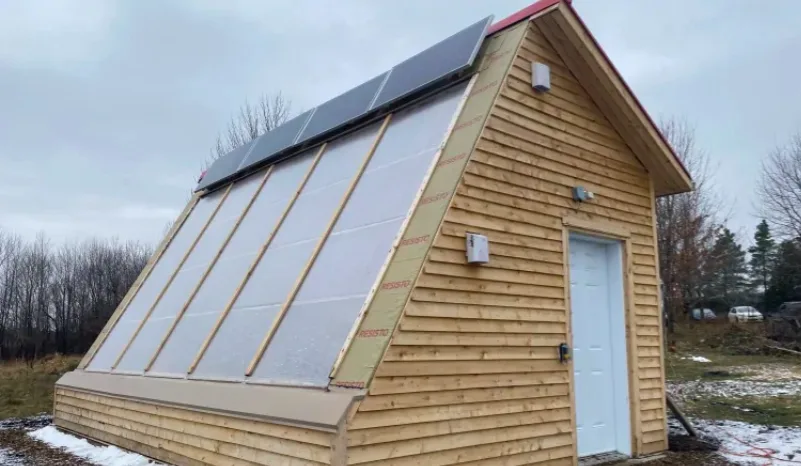
Université de Sherbrooke students create a greener greenhouse
Three engineering students at l'Université de Sherbrooke spent three years designing and building their perfect greenhouse.
They set out to build a smart green building, which would be entirely off-grid, and a model for future construction projects, while also promoting food autonomy.
The three-by-six-metre structure — called VG360 — is made of cedar, with an inclined south-facing window wall, solar panels, and a red metal roof.
And it does not need a power source.

Nestled behind a farm in the Eastern Townships, the off-grid greenhouse is meant to be a model for future construction projects, while also promoting food autonomy. (Spencer Van Dyk/CBC)
"We believe it is possible to build greenhouses — and other houses — using less power," said Valerie Pouliot, one of the students on the project. "We want to build green to be better for the environment."
The team started by excavating five feet into the ground, and then added insulation using rocks and sand, essentially creating an underground cooler, into which the greenhouse will pump hot air, explained building engineering student Raphael Boisjoly-Sallafranque.
The double-beamed walls and roof each have more than a foot of insulation, so all the heat that's brought into the building thanks to the window and solar panels will stay inside, keeping the greenhouse warm during the cold winter months.

The angled south-facing window wall is designed to bring heat from the sun into the greenhouse, while thick insulated walls keep it in, so the structure can stay warm throughout the cold winter months. (Spencer Van Dyk/CBC)
"It's gonna be our first test winter, so we're gonna be able to see the performance of it," Boisjoly-Sallafranque said. "Which is why we haven't released the plans yet, because we want to make sure the concept is viable."
The solar panels generate electricity, which can be stored and used for at least three days in the event of inclement weather, Pouliot explained.
"Just with the sun coming in, you can do all that, so it's not harder than being aligned with the sunlight," she said.
A hot air collector near the ceiling of the greenhouse will then push all the hot air down into the soil, where all the plants will grow directly in the ground.
The group intends to release the plans for the greenhouse, including the structure itself and the technology, via open source, so anyone can have access to it.

Building engineering student Raphael Boisjoly-Sallafranque says the greenhouse's battery acts as its grid, and it stores energy in the event of inclement weather. (Spencer Van Dyk/CBC)
The prototype, which was built over four months this summer at a farm in Durham-Sud, 50 kilometres northwest of Sherbrooke, cost about $25,000.
But Pouliot says future builds will cost less because anyone hoping to have their own off-grid greenhouse wouldn't have the same data collecting costs the students had.
She said especially during the COVID-19 pandemic, people seem to be working toward being more self-sufficient and sustainable, and she thinks an off-grid greenhouse aligns with those goals.
While energy efficient buildings are fairly common, the team wanted the food security and food autonomy elements of the project highlighted.

The greenhouse's mechanical system, which includes its solar panel controls, battery, and a pump to send hot air into the soil to help plants grow. (Spencer Van Dyk/CBC)
"Our grid is like the battery system, so it's like a typical off-grid with a battery bank system," Boisjoly-Sallafranque said. "There are a bunch already out there, but the thing is to put it inside of a greenhouse."
The team plans to get seeds in the ground in the next few weeks, and will spend the winter months tracking the greenhouse's efficiency.
"Now it's the hard part, and the fun part for myself, particularly because I love the control world and the data collecting part of this," Boisjoly-Sallafranque said.
The students hope to release the open source plans by late Spring 2021.
This article was originally published by CBC News and written by Spencer Van Dyk.










